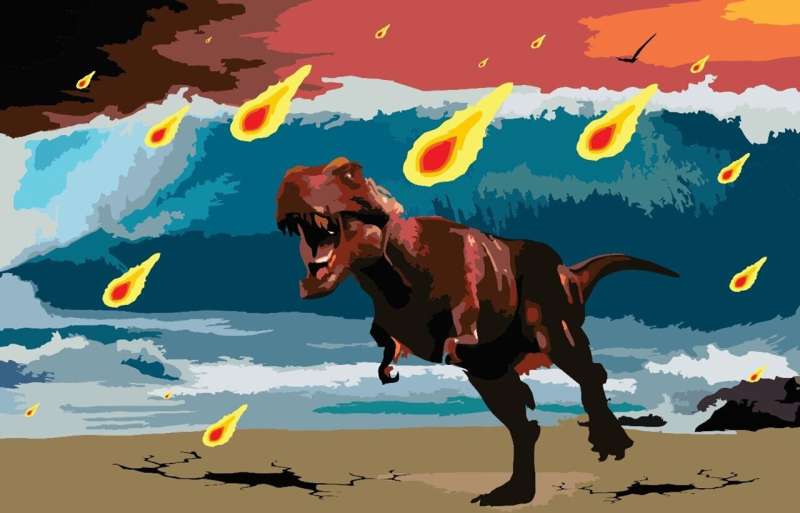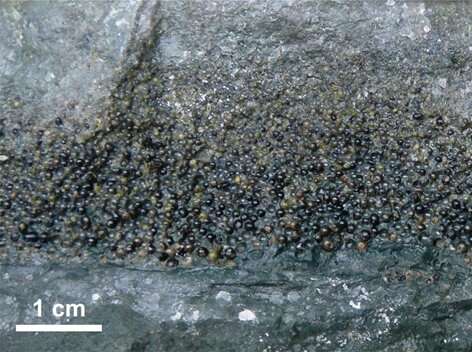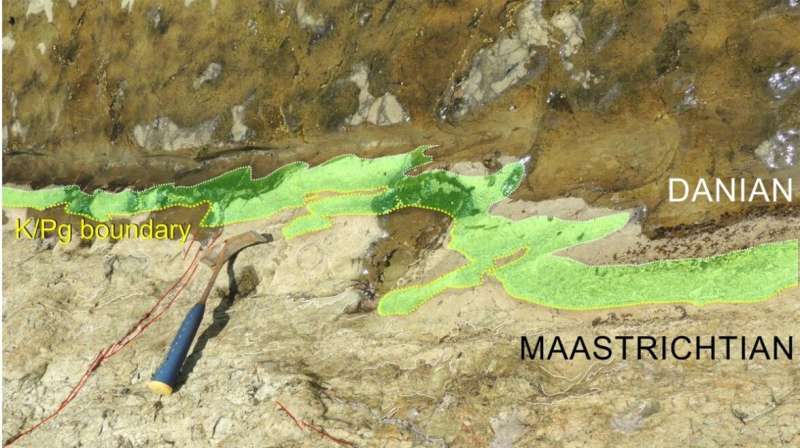Impact that killed the dinosaurs may have triggered a 'mega-earthquake' that lasted weeks to months

Some 66 million years ago, a 10-kilometer asteroid hit Earth, triggering the extinction of the dinosaurs. New evidence suggests that the Chicxulub impact also triggered an earthquake so massive that it shook the planet for weeks to months after the collision. The amount of energy released in this "mega-earthquake" is estimated at 1023 joules, which is about 50,000 times more energy than was released in the magnitude 9.1 Sumatra earthquake in 2004.
Hermann Bermúdez will present evidence of this "mega-earthquake" at the upcoming GSA Connects meeting in Denver this Sunday, October 9. Earlier this year, Bermúdez visited outcrops of the infamous Cretaceous-Paleogene (K-Pg) mass extinction event boundary in Texas, Alabama, and Mississippi to collect data, supplementing his previous work in Colombia and Mexico documenting evidence of the catastrophic impact.
In 2014, while doing fieldwork on Colombia's Gorgonilla Island, Bermúdez found spherule deposits—layers of sediment filled with small glass beads (as large as 1.1 mm) and shards known as "tektites" and "microtektites" that were ejected into the atmosphere during an asteroid impact. These glass beads formed when the heat and pressure of the impact melted and scattered the crust of the Earth, ejecting small, melted blobs up into the atmosphere, which then fell back to the surface as glass under the influence of gravity.

The rocks exposed on the coast of Gorgonilla Island tell a story from the bottom of the ocean—roughly 2 km down. There, about 3,000 km southwest of the site of the impact, sand, mud, and small ocean creatures were accumulating on the ocean floor when the asteroid hit. Layers of mud and sandstone as far as 10–15 meters below the sea floor experienced soft-sediment deformation that is preserved in the outcrops today, which Bermúdez attributes to the shaking from the impact.
Faults and deformation due to shaking continue up through the spherule-rich layer that was deposited post-impact, indicating that the shaking must have continued for the weeks and months it took for these finer-grained deposits to reach the ocean floor. Just above those spherule deposits, preserved fern spores signal the first recovery of plant-life after the impact.
Bermúdez explains, "The section I discovered on Gorgonilla Island is a fantastic place to study the K-Pg boundary, because it is one of the best-preserved and it was located deep in the ocean, so it was not affected by tsunamis."

Evidence of deformation from the mega-earthquake is also preserved in Mexico and the United States. At the El Papalote exposure in Mexico, Bermúdez observed evidence of liquefaction—when strong shaking causes water-saturated sediments to flow like a liquid. In Mississippi, Alabama, and Texas, Bermúdez documented faults and cracks likely associated with the mega-quake. He also documented tsunami deposits at several outcrops, left by an enormous wave that was part of the cascading catastrophes resulting from the asteroid collision.
Bermúdez will deliver a talk about evidence for the mega-earthquake at the GSA Connects meeting in Denver on Sunday, October 9. He will also present a poster about his observations of tsunami deposits and earthquake-related deformation on Monday, October 10, which will be available in English, Spanish, Italian, French, and Chinese. In discussing his research, he emphasized the important role collaboration has played in visiting and studying so many outcrops that tell the story of this extreme event in Earth's history.
More information: (Abstract) The Chicxulub Mega-Earthquake: Evidence From Colombia, Mexico, And The United States
Provided by Geological Society of America




















